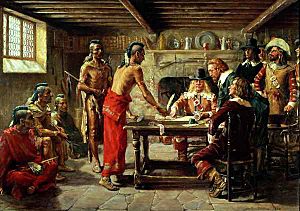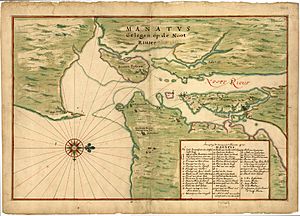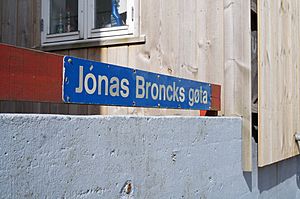Jonas Bronck facts for kids
Jonas Bronck was an important immigrant who came to the Dutch colony of New Netherland a long time ago, in the 1600s. He was born around the year 1600 and passed away in 1643. The famous Bronx River and, because of that, the whole area known as the Bronx in New York City are named after him! You can even see a painting of Jonas Bronck arriving in New Netherland at the Bronx County Courthouse, which was made in the 1930s.
Contents
Where Did Jonas Bronck Come From?
People have different ideas about where Jonas Bronck was born.
Some believe he came from the Faroe Islands, a group of islands that were part of Denmark and Norway back then. There's even a street named after him in Tórshavn, the capital of the Faroe Islands! This idea suggests he was the son of a minister.
Other sources from the early 1900s say he was Danish. A famous book about New York City's history, Gotham: A History of New York City to 1898, also mentions him as Danish. Some even thought he was a Mennonite who left the Netherlands for Denmark to escape religious problems.
However, a strong idea suggests Jonas Bronck was Swedish. This theory comes from research done in the Netherlands, Sweden, and New York. Important documents from 1638 and 1639 show his middle name was Jonsson. This means his father's first name was Jonas. Researchers believe he was born around 1600 in a place called Komstad in Småland, a region in Sweden.
The official historian of the Bronx, Lloyd Ultan, and the The Bronx County Historical Society now mostly agree with the idea that Jonas Bronck was Swedish.
Jonas Bronck's Marriage
On June 18, 1638, Jonas Bronck signed his marriage papers as Jonas Jonasson Bronck. This name shows that his father's name was Jonas, which supports the idea that he was Swedish. He married his Dutch wife, Teuntje Joriaens, in Amsterdam, Netherlands, on July 6, 1638.
Moving to New Netherland
Jonas Bronck decided to leave Europe and move to the new lands across the ocean for several reasons.
In the late 1630s, big changes were happening in both Holland and America. The Dutch West India Company (WIC) controlled New Netherland, which stretched between the Delaware and Connecticut rivers. The main trading center was New Amsterdam, located at the bottom tip of Manhattan Island.
After a big economic crash in Holland called the "Tulip mania" in 1637, the Dutch government thought about taking control of New Netherland from the WIC. They wanted to use the colony to help people who had lost money. Also, the WIC hadn't done much to grow New Netherland beyond just trading furs, while English settlements nearby were growing fast.
New Amsterdam only had about 400 people, and the WIC's properties looked neglected. To avoid losing control, the company sent Willem Kieft to be the new leader of New Netherland. He arrived in 1638 and quickly bought more land from the Lenape people around Manhattan. He also made it easier for people to settle there by changing old rules that made it hard for settlers to own land or do business freely.
Jonas Bronck saw these changes as a great chance. He was one of the first to realize the opportunities and, like many other people from Europe, he sailed across the Atlantic to settle in the areas around New Amsterdam.
In the spring of 1639, Jonas Bronck and other settlers, including his friend Jochem Pietersen Kuyter, left the Dutch port of Hoorn. Their ship, "De Brandt van Troyen" (which means "Fire of Troy"), carried many cattle. On June 16, their ship arrived in the harbor of New Amsterdam.
Jonas Bronck's Home
Jonas Bronck and Jochem Kuyter sailed up the East River to land that belonged to the Siwanoy and Wappinger Native American groups. Jonas Bronck was very happy with his new home. He wrote that he felt "guided... to this beautiful country, a land covered with virgin forest and unlimited opportunities." He called it "a veritable paradise."
Kuyter chose land on the west side of Manhattan Island, while Bronck settled on the mainland. Jonas and Teuntje Bronck's house was built near where the Harlem River and the Bronx Kill meet, across from Randalls Island. Their house was like "a miniature fort with stone walls and a tile roof."
Bronck's farm was about 274 hectares (677 acres) in size. Because he was a religious man, he named his farm Emaus. This name comes from the New Testament where Jesus appeared to his followers after his resurrection. Today, this area is part of Mott Haven in the Bronx.
Relations with Native American Tribes
On April 22, 1642, an important peace treaty was signed at Jonas Bronck's home. It was between the Dutch leaders and the Wecquaesgeek Native American chiefs, Ranaqua and Tackamuck. This event is shown in a painting by the American artist John Ward Dunsmore.
Sadly, on February 23, 1643, the Dutch leader Willem Kieft ordered an attack on Native American refugee camps. These tribes, the Wecquaesgeek and Tappan, had been pushed south by other powerful tribes and had sought protection from the Dutch. Kieft's attacks, known as the Pavonia Massacre, led to Native American groups attacking many Dutch settlements, including some in what is now the Bronx. We don't know if Jonas Bronck's death was connected to these fights.
Jonas Bronck's Last Wishes
Soon after Jonas Bronck died in May 1643, his wife Teuntje and Peter Bronck made a list of everything on their farm, Emaus. This was done with the help of a minister and Jonas Bronck's friend, Jochem Pietersen Kuyter. Teuntje remarried in June 1643 and moved away.
The list of items on the farm shows what Jonas Bronck and his family had built in less than four years. There was a stone house with a tile roof, a barn, two small buildings for farm workers, and a tobacco house. They also had 25 farm animals and many hogs running in the nearby woods.
Unlike many people at the time who couldn't read or write, Jonas Bronck was very educated. His personal library was impressive for that time and place. It showed he could read in four languages! His library included Bibles, religious books, history books, a Danish law book, a Danish child's book, and many other books and pamphlets.
How "Bronck's" Became "The Bronx"
Jonas Bronck's farm, about 274 hectares (677 acres), was known as Emaus, Bronck's Land, or simply Bronck's. Today, this area is roughly around Willis Avenue and 132nd Street in Mott Haven.
After Jonas Bronck died, his land was passed between different Dutch traders. In 1664, it was bought by Samuel Edsall, and then in 1670, it went to Captain Richard Morris and Colonel Lewis Morris. Four years later, Colonel Morris got a special permission from the king for Bronck's Land, and it became known as the Manor of Morrisania.
Even though Jonas Bronck only lived there for four years, the area was called "Broncksland" until the end of the 1600s. The way we spell "Bronx" today started being used in 1697.
Jonas Bronck's Family
Pieter Bronck, who was born in 1616 in Sweden, was likely Jonas Bronck's brother or cousin, not his son. This is because they had the same father's name (Jonas) and a similar age difference. Pieter Bronck moved to the Hudson Valley around 1650. The Pieter Bronck House in Coxsackie, New York, is a registered historic place today. The American poet William Bronk said he was a descendant of Pieter Bronck.
Jonas Bronck's Legacy
Things Named After Him
There's a street in Tórshavn, Faroe Islands, called "Jónas Broncksgøta." In the Bronx, there's the Jonas Bronck Academy and Public School 43 Jonas Bronck. You can even find a local brewery that makes Jonas Bronck Beer!
Jonas Bronck Center
There's a Jonas Bronck Center in Sävsjö, Sweden, which is near where some believe Jonas Bronck was born. In August 2014, they celebrated the 375th anniversary of Jonas Bronck settling in the Bronx. This celebration was largely the idea of Brian G. Andersson, a specialist in Bronck's family history and a founding director of the center.
See also
 In Spanish: Jonas Bronck para niños
In Spanish: Jonas Bronck para niños




